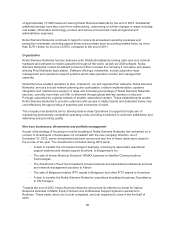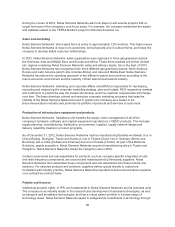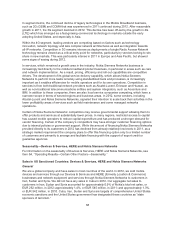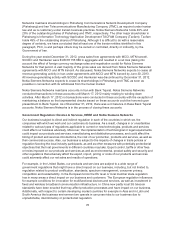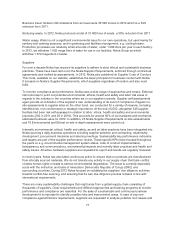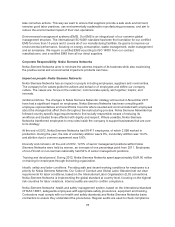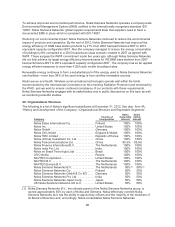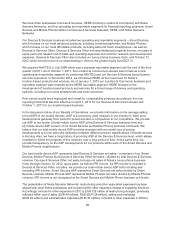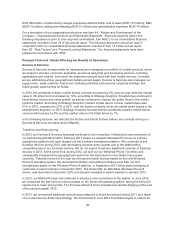Nokia 2012 Annual Report Download - page 75
Download and view the complete annual report
Please find page 75 of the 2012 Nokia annual report below. You can navigate through the pages in the report by either clicking on the pages listed below, or by using the keyword search tool below to find specific information within the annual report.Labor Conditions at manufacturing facilities. At December 31, 2012, Nokia had close to 18000
employees working directly in production, including manufacturing, packaging and shipping. A healthy,
motivated workforce is vital for Nokia’s success and as part of this management we carry out
third-party in-depth assessments of our factories’ labor conditions every second year. The latest
assessment round started in 2012 and six of our seven major facilities had been assessed by the end
of February 2013. Our focus this year has been on emphasizing a proper root cause analysis in order
to sustain the high level of compliance in social responsibility. During the intervening period of
third-party assessments, we conduct internal reassessments to ensure any necessary corrective
actions have been made.
All assessments at our manufacturing facilities are carried out against the Nokia Labour Requirements,
as well as all local laws. The Nokia Labour Requirements provide a framework to monitor and assess
labor conditions in a consistent manner and are based on recognized international standards such as
the International Labour Organization and UN Human Rights conventions. A revision of the Nokia
Labour Requirements was launched in our manufacturing facilities in 2012. The update was done to
respond to the need for specifications in areas such as sick leave and maternity leave practices, and
protection of pregnant women at work. We also recognize the right of employees to join unions and
enter into collective bargaining agreements. Almost all of our manufacturing facilities have collective
agreements in place with one or more labor unions. At December 31, 2012, approximately 60% of our
production employees were covered by collective bargaining agreements.
Nokia Code of Conduct. In 2012 we continued our ongoing commitment to actively fight improper
business practices, including corruption, and believe that as a global company, we can play an
important role in this area. We also believe that our efforts can provide us with a competitive advantage
with customers who demand high ethical standards in their supply chain. For these reasons, the Nokia
Code of Conduct is available in 34 languages and can be found on our website. Since 2009, we have
conducted a program to train each employee on our Code of Conduct using an e-learning that is
offered in 14 languages as well as classroom training. By the end of 2012, 95% of eligible non-
manufacturing-based employees completed their training and in our manufacturing facilities 98% of
eligible employees completed their classroom training. For the first time, we now formally track and
measure our former NAVTEQ employees’ (now in HERE) completion of the mandatory Code of
Conduct training. We have several communications channels available to employees and others to get
help in understanding and applying the Code of Conduct, or to report concerns of violations, including
a “Contact the Board” channel for contacting the Board of Directors anonymously.
Human rights. Improved communications provide better opportunities for freedom of expression, and
therefore promote civil and political rights as well as economic and social rights. At the same time, we
have specific human rights responsibilities toward our employees, customers, the communities where
we work, and within our supply chain. We apply UN Human Rights special representative John
Ruggie’s business and human rights framework to our business practices. The ‘Protect, Respect and
Remedy’ framework has been widely welcomed by industry and governments. Since 2011, we have
had in place the Nokia Human Rights Approach, which is based on Ruggie’s framework and which is
also available on our website.
Suppliers. Our sustainability efforts relating to our supply chain are discussed below under “Impact on
the environment:Devices & Services and HERE.”
Customer privacy. As the Internet has expanded and new services for consumers have emerged, user
privacy has become increasingly important. Consumers have increasing possibilities to use and share
their personal information in new contexts. To remain a trusted brand, we work proactively to ensure
that this custodial information is protected. Respect for privacy is part of our commitment to observing
high standards of integrity and ethical conduct in all our operations. We have a formal privacy program
with a senior executive accountable for it.
74



